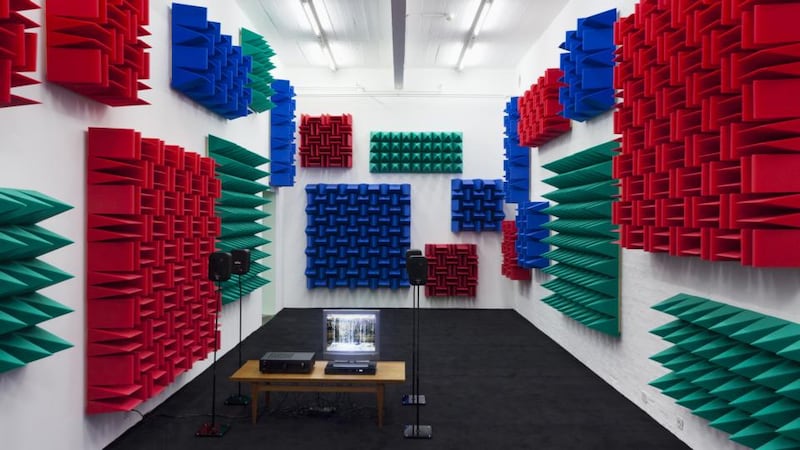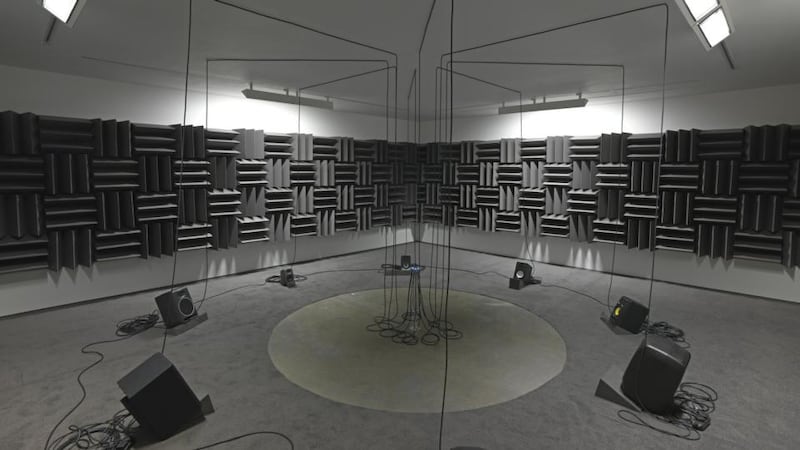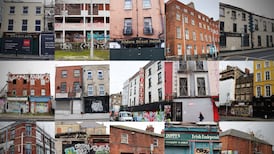It's hard to describe Haroon Mirza's exhibition Are jee be? at Imma. Embark on an account of its many components and layers of reference and it quickly begins to sound clogged, confusing and perhaps confused. It is a jumble, but it's supposed to be a jumble.
There’s no harm in tracing the various contributory strands, but its meaning does not reside in disentangling those individual strands. Think of it instead as akin to a piece of music, one incorporating sound, image and space. Then try to experience it in that way.
Mirza, London-born and resident, studied at Chelsea and Goldsmiths. Now, in his mid-30s, he finds himself in huge demand internationally.


He has won several awards, including a coveted prize at the 2011 Venice Biennial. The installation that forms the substance of Are jee be? has its own title, The System . It occupies a stretch of corridor and the four adjacent galleries in Imma. Mirza sums it up rather well when he says: "You could think of the whole space as being like a circuit board."
Sure enough, the entire place is conspicuously wired up, linked by flat bands of conductor and cables from which sprout many connections, to sets of speakers, LED strips, video monitors, a projector and, in the corridor, an array of solar-powered electricity generating panels. One thinks of multimedia set-ups in music clubs. Rightly so: Mirza points to one small grey box tucked away in a corner. “That’s what controls everything. It’s a kind of custom-built multi-media player.”
He has often explained how, as a child, he had the not uncommon impulse to take things apart, but to an extreme degree. “My idea was that I was ‘fixing’ things, but I guess I was breaking them really,” he says, laughing.
He wanted to see how they worked and he had the notion of making something else from them. That same curiosity still informs his art. “I never had any formal training, technologically. I mean I don’t know electronics in that sense. But that’s just as well. I do the stuff you shouldn’t do because I don’t know the stuff you should do.”
In other words, he takes all the technology and shapes it to his own ends, sometimes in an almost naive way. “There’s nothing hugely complicated here. It’s all fairly simple, really.”
It may be simple, but it generates complexity. The foundation of the exhibition is formed of the remnants of part of Imma's extremely popular Eileen Gray show: the explanatory panels and the video elements.
Mirza usually shapes work to particular spaces and when he visited Imma, the Eileen Gray show was still running. “I immediately thought, well, I’d like to incorporate what was in the space at the time as part of my exhibition, though I didn’t have a clue as to how I was going to do that.”
In the event he has left the Eileen Gray material in place and made several notable additions, including his now trademark batteries of spiky, triangular sound-absorbing foam panels arranged against the walls.
They are colour-keyed, room by room. Are Jee Be? refers to red, green and blue, the primary colours employed in processing images electronically. Mirza takes the images, including videos of the curator of the Eileen Gray show discussing the exhibition and – another addition – Björk's idiosyncratic video explanation of how television works, and throws them into his multi-media mix.
The buzzes, clicks and hisses we hear through the speakers hint at a rhythmic structure, like a particularly austere, extreme form of techno. “Music is organised sound and mathematics,” Mirza is fond of pointing out (he DJs on occasion), and this is organised sound, generated by the little grey box.
“What you hear is the sound of the pulses of electricity. It’s a system that borders on chaos, like nature, and once it’s started, it’s autonomous.” The video images are interrupted and fragmented by the same patterns of pulses, so that sound, image, light, space and time all go to make the overall work. “It’s a composition, in the way that a painting is a composition, but involving real time and real space.”
What is interesting here is that he aims to treat everything, from the Eileen Gray material to the fabric of the building, from several forms of colour to the light coming through the windows, as raw materials to work with.
Taken as a whole, his installation unmistakably evokes the 19th-century idea of the Gesamtkunstwerk , most usually associated with Wagner: a total work of art that synthesises all art forms in one.
Mirza emphasises that the installation is not about Eileen Gray in any conventional sense, but he’s intrigued by the fact that, as chance would have it, his next project will be in Le Corbusier’s Villa Savoye at Poissy on the outskirts of Paris.
Le Corbusier and Gray had a difficult friendship that ended in discord, and he is generally considered to have treated her shabbily. “So,” Mirza notes, “it’s going to be interesting going from one world into the other.”
Are Jee Be?
by
Haroon Mirza
is at the
Irish Museum of Modern Art
, Royal Hospital Kilmainham until June 8th. See imma.ie
















